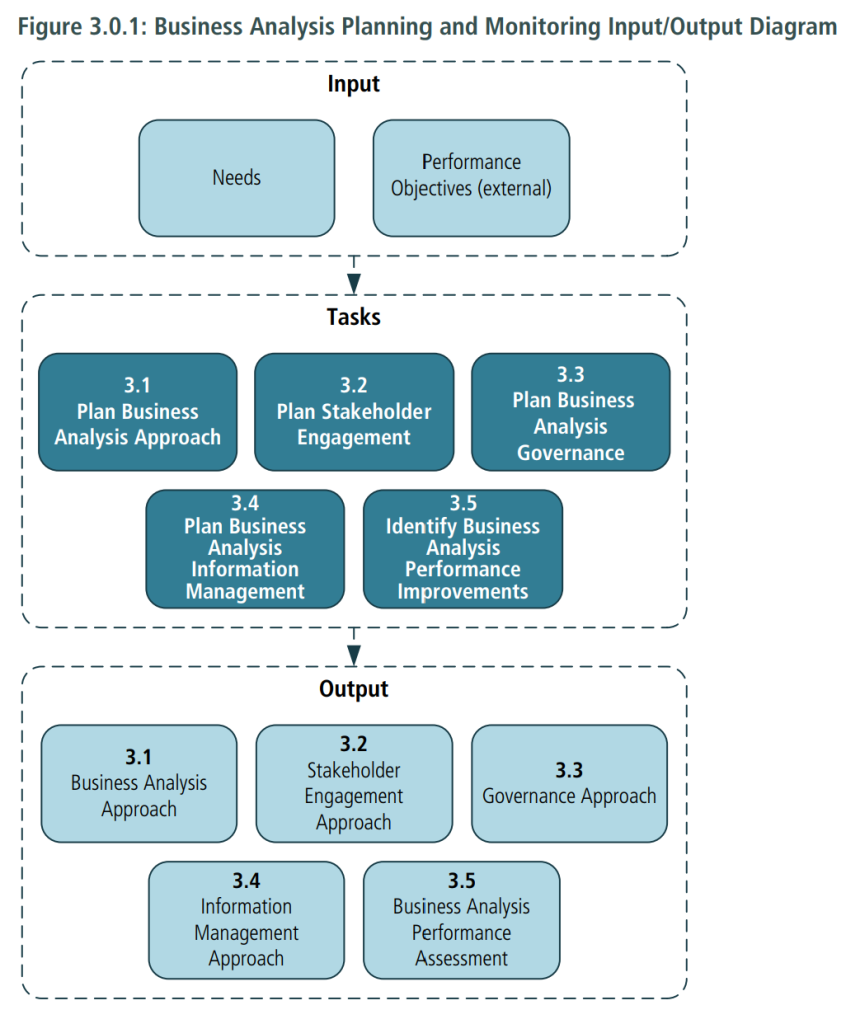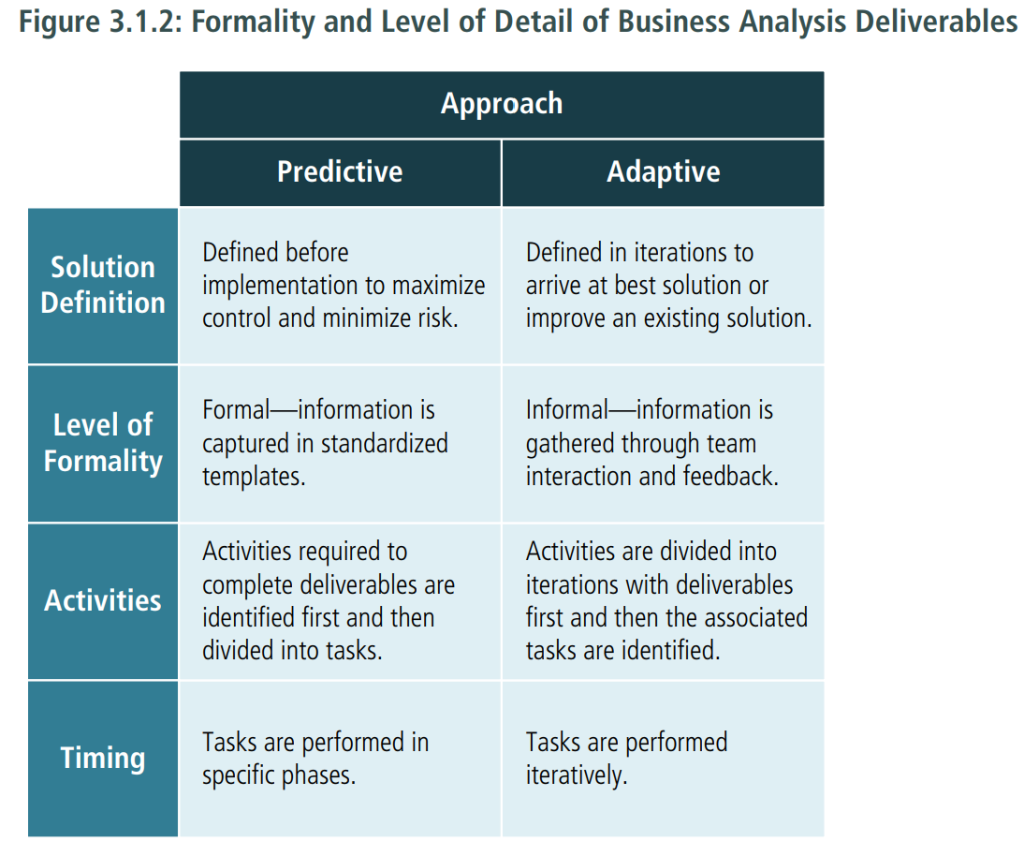3.1.1 Purpose
The purpose of Plan Business Analysis Approach is to define an appropriate method to conduct business analysis activities.
3.1.2 Description
Business analysis approaches describe the overall method that will be followed when performing business analysis work on a given initiative, how and when tasks will be performed, and the deliverables that will be produced.
The business analyst may also identify an initial set of techniques to use. This list may change as the initiative proceeds and the business analyst gains a deeper understanding of the change and its stakeholders.
The business analysis approach may be defined by a methodology or by organizational standards. In some organizations, elements of the business analysis approach may be standardized and formalized into a repeatable business analysis process which can be leveraged for each effort. Even where a standard approach exists, it may be tailored to the needs of a specific initiative. Tailoring may be governed by standards that define which approaches are permitted, which elements of those processes may be tailored, and general guidelines for selecting a process.
If organizational standards do not exist, the business analyst works with the appropriate stakeholders to determine how the work will be completed. For example, if the change is delivered via a project, the standards and approach may be developed during the project planning phase.
The business analysis approach should:
- align to the overall goals of the change,
- coordinate the business analysis tasks with the activities and deliverables of the overall change,
- include tasks to manage any risks that could reduce the quality of business analysis deliverables or impede task efficiency, and
- leverage approaches and select techniques and tools that have historically worked well.
3.1.3 Inputs
• Needs: the business analysis approach is shaped by the problem or opportunity faced by the organization. It is necessary to consider what is known about the need at the time of planning, while acknowledging that understanding evolves throughout business analysis activities

3.1.4 Elements
.1 Planning Approach
There are various planning methods used across perspectives, industries, and enterprises. Many planning methods fit somewhere along a continuum between predictive and adaptive approaches.
Predictive approaches focus on minimizing upfront uncertainty and ensuring that the solution is defined before implementation begins in order to maximize control and minimize risk. These approaches are often preferred in situations where requirements can effectively be defined ahead of implementation, the risk of an
incorrect implementation is unacceptably high, or when engaging stakeholders presents significant challenges.
Adaptive approaches focus on rapid delivery of business value in short iterations in return for acceptance of a higher degree of uncertainty regarding the overall delivery of the solution. These approaches tend to be preferred when taking an exploratory approach to finding the best solution or for incremental improvement of an existing solution.
Different approaches may be used within the same initiative. Among other factors, the business analyst may consider the organization’s standards, tolerance for uncertainty, and previous experience with different approaches when planning for business analysis activities.
Regardless of the approach, planning is an essential task to ensure value is delivered to an enterprise. Planning typically occurs more than once on a given initiative as plans are updated to address changing business conditions and newly raised issues. The business analysis approach should describe how plans will be altered if changes are required.
.2 Formality and Level of Detail of Business Analysis Deliverables
When defining the business analysis approach, consider the level of formality that is appropriate for approaching and planning the initiative.
Predictive approaches typically call for formal documentation and representations. Business analysis information may be captured in a formal document or set of representations following standardized templates.
Information is captured at various levels of detail. The specific content and format of business analysis information can vary depending on the organizational methodologies, processes, and templates in use.
Adaptive approaches favor defining requirements and designs through team interaction and gathering feedback on a working solution. Mandatory requirements representations are often limited to a prioritized requirements list.
Additional business analysis documentation may be created at the discretion of the team, and generally consists of models developed to enhance the team’s understanding of a specific problem. Formal documentation is often produced after the solution is implemented to facilitate knowledge transfer.
Other considerations that may affect the approach include:
- the change is complex and high risk,
- the organization is in, or interacts with, heavily regulated industries,
- contracts or agreements necessitate formality,
- stakeholders are geographically distributed,
- resources are outsourced,
- staff turnover is high and/or team members may be inexperienced,
- requirements must be formally signed off, and
- business analysis information must be maintained long-term or handed over for use on future initiatives.

.3 Business Analysis Activities
A business analysis approach provides a description of the types of activities that the business analyst will perform. Frequently the organization’s adopted methodologies influence the activities that are selected.
Integrating business analysis activities in the business analysis approach includes:
- identifying the activities required to complete each deliverable and then breaking each activity into tasks,
- dividing the work into iterations, identifying the deliverables for each iteration, and then identifying the associated activities and tasks, or
- using a previous similar initiative as an outline and applying the detailed tasks and activities unique to the current initiative.
.4 Timing of Business Analysis Work
Business analysts determine when the business analysis tasks need to be performed and if the level of business analysis effort will need to vary over time.
This type of planning includes determining whether the business analysis tasks performed within the other knowledge areas will be performed primarily in specific phases or iteratively over the course of the initiative.
The timing of business analysis activities can also be affected by:
- the availability of resources,
- priority and/or urgency of the initiative,
- other concurrent initiatives, or
- constraints such as contract terms or regulatory deadlines.
.5 Complexity and Risk
The complexity and size of the change and the overall risk of the effort to the organization are considered when determining the business analysis approach. As complexity and risk increase or decrease, the nature and scope of business analysis work can be altered and reflected in the approach.
The approach may also be altered based on the number of stakeholders or business analysis resources involved in the initiative. As the number of stakeholders increases, the approach may be adjusted to include additional process steps to better manage the business analysis work.
Other factors that can impact complexity include:
- size of the change,
- number of business areas or systems affected,
- geographic and cultural considerations,
- technological complexities, and
- any risks that could impede the business analysis effort.
Factors that can impact the risk level of a business analysis effort include:
- experience level of the business analyst,
- extent of domain knowledge held by the business analyst,
- level of experience stakeholders have in communicating their needs,
- stakeholder attitudes about the change and business analysis in general,
- amount of time allocated by stakeholders to the business analysis activities,
- any pre-selected framework, methodology, tools, and/or techniques imposed by organizational policies and practices, and
- cultural norms of the organization.
.6 Acceptance
The business analysis approach is reviewed and agreed upon by key stakeholders. In some organizations, the business analysis process may be more structured and require key stakeholders to sign off on the approach to ensure all business analysis activities have been identified, estimates are realistic, and the proposed roles and responsibilities are correct. Any issues raised by stakeholders when reviewing the approach are documented by the business analyst and resolutions are sought. Stakeholders also play a role in reviewing and accepting changes to the approach as alterations are made to accommodate changing conditions.

Those guidelines additionally worked to become a good way to recognize that other people online have the identical fervor like mine to grasp great deal more around this condition.